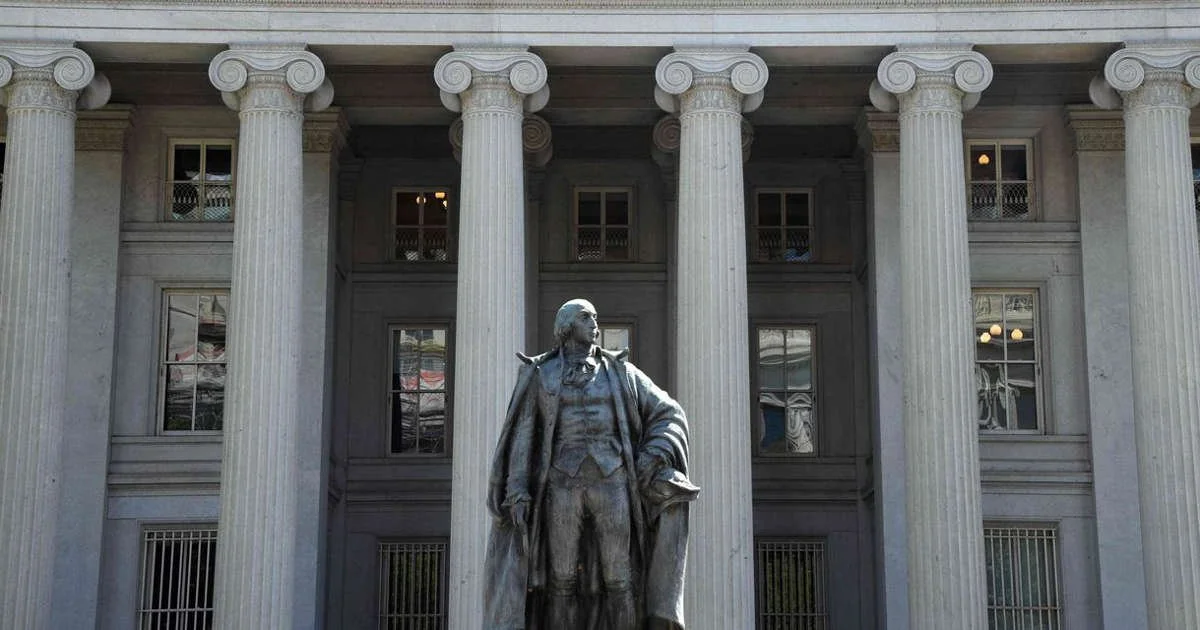
A Fragile Foundation: Treasury Auctions and the Shaky Ground Beneath America’s Economy
Posted in :
The latest U.S. Treasury auctions reveal a fragile fiscal foundation—rising yields, fading demand, and a deepening credibility gap that could trigger global consequences if unaddressed.
Recent turbulence in U.S. Treasury auctions signals deeper cracks in America’s economic foundation. Amid record-high yields and flagging investor confidence, Wall Street is reflecting growing global skepticism about U.S. fiscal management. With the risk of contagion looming, it’s time for policymakers to confront the hard truths behind their economic strategies.
It started with an odd moment over morning coffee: the news alert about a disappointing Treasury bond auction outshone even the latest gossip from Capitol Hill. In that instant, it was clear something bigger was brewing. Bond auctions rarely grab headlines, but this time, the numbers were too loud to ignore. Across trading desks and dinner tables alike, people are asking if America’s financial bedrock is beginning to crack.
Wall Street Feels the Chill: Anatomy of a Troubled Treasury Auction
On May 21, 2024, Wall Street was rattled by the results of a key Treasury auction, sending a chill through global markets. The U.S. Treasury’s 20-year bond auction delivered disappointing auction results, with a bid-to-cover ratio of just 2.46—a clear signal that investor demand was underwhelming. The yield on these bonds spiked to 5.047%, marking the highest level seen in five years. For market watchers and policymakers alike, these numbers were more than just data points; they were a warning shot.
The bid-to-cover ratio is a crucial piece of market data in bond auctions, reflecting the level of demand for government debt. A higher ratio indicates strong investor appetite, while a lower figure—like the 2.46 seen here—suggests growing skepticism. Investors, it seems, are demanding higher returns to compensate for perceived risks in U.S. fiscal management.
The immediate reaction was swift and classic. Stocks tumbled, bond yields soared, and the dollar softened. The market’s verdict was clear: confidence in Washington’s economic stewardship is eroding. The timing could hardly be worse. Moody’s recent downgrade of the U.S. credit rating has already layered anxiety onto the financial system, amplifying fears about fiscal instability and the sustainability of America’s debt trajectory.
The May 21 auction was not an isolated event. Just a day later, the 30-year Treasury bond yield surged to 5.15% intraday before closing at 5.05%. These figures underscore a broader trend—investors are recalibrating their appetite for long-term U.S. debt. The Treasury conducts regular Treasury auctions for a range of securities, from bills and notes to bonds, FRNs, and TIPS. Each auction’s market data is closely watched, and the government maintains records of the highest and lowest yields, offering amounts, and bid-to-cover ratios for each security type. But rarely do these numbers paint such a stark picture.
The underlying issue is not just technical, but political. The latest tax-and-spend package from House Republicans, aligned with Donald Trump’s economic agenda, is projected to add $3.8 trillion to the national debt over the next decade. Investors are starting to wonder: does Washington have any real plan to reverse the fiscal tide? The answer, at least for now, seems to be no.
This lack of confidence is not unique to the United States. Japan, facing its own demographic and economic headwinds, saw its 20-year bond auction record the weakest demand since 2012, with yields spiking to levels not seen in decades. The parallel struggles in Washington and Tokyo suggest a global shift: fiscal indiscipline is losing its market cachet. Investors are no longer willing to underwrite government debt without demanding a premium.
For decades, U.S. Treasurys have been the bedrock of the global financial system—a safe haven in turbulent times. The dollar’s status as the world’s reserve currency has rested on assumptions of stability and institutional maturity. Now, all three are in question. The sputtering auction of long-term debt—once considered sacrosanct by global investors—signals a deeper erosion of faith in U.S. fiscal management and political coherence.
There is a growing temptation among central bankers to reach for quantitative easing, hoping to soothe markets with another round of liquidity. But as research shows, such measures are only temporary fixes. They may mask the symptoms, but they do not address the underlying fiscal rot. Worse, they risk creating a cycle where fiscal irresponsibility is not just tolerated, but incentivized, under the assumption that the central bank will always intervene.
This moral hazard is not theoretical. It undermines democratic accountability, removing incentives for lawmakers to make tough decisions on spending, taxation, and entitlement reform. The drama playing out on Wall Street is a symptom of a broader malaise: the decoupling of economic decision-making from political courage.
Meanwhile, the White House continues to deflect, blaming foreign adversaries while ignoring the unsustainable structure at home. The bond market’s message is clear—the margin for error is shrinking. Investors are not interested in patriotic rhetoric; they want to know if the U.S. can pay its bills. And right now, they are not reassured.
As economist Herbert Stein remarked with characteristic clarity: “If something cannot go on forever, it will stop.”
Fiscal Fantasies and Realities: The Cost of Political Theater
The American economy, long seen as the world’s financial anchor, is showing cracks beneath its surface. Recent events in the Treasury securities market have exposed the risks of fiscal policy choices that prioritize spectacle over substance. Washington’s persistent spending sprees and tax cuts are finally colliding with economic reality, and the numbers are impossible to ignore.
On Capitol Hill, lawmakers have advanced a sweeping tax-and-spend package, advertised as a cure-all for economic sluggishness. Yet, research shows this proposal could add a staggering $3.8 trillion to the national debt over the next decade. The implications of such a move are not lost on investors, who are increasingly wary of the sustainability of U.S. fiscal policy. The question is no longer whether the math will catch up, but when.
The latest 20-year U.S. Treasury bond auction sent a clear signal. Demand was lackluster, with a bid-to-cover ratio of just 2.46 and yields climbing to 5.047 percent—the highest in five years. This is more than a technical hiccup. It’s a resounding vote of no confidence in America’s fiscal management. As the auction results hit the wires, stocks tumbled, bond yields soared, and the dollar retreated. The message from the markets was unmistakable: the era of easy money and unchecked borrowing may be drawing to a close.
The U.S. is not alone in facing these challenges. Just a day before the American auction, Japan’s 20-year bond auction recorded its weakest demand since 2012, with yields reaching levels not seen since the early 2000s. The parallel struggles of these two economic giants are more than a coincidence. They reflect a broader shift in investor sentiment toward long-term debt and fiscal discipline. As one analyst put it,
“The margin for error is narrowing. Investors want to know whether the empire can pay its bills.”
For decades, U.S. Treasury securities have been considered the bedrock of global finance—a safe haven in times of turmoil. The dollar’s status as the world’s reserve currency has rested on the assumption of American stability and prudent fiscal policy. But as the national debt balloons and bond auctions falter, that foundation looks increasingly fragile. Studies indicate that U.S. fiscal policies now have profound implications for global economic stability and investor confidence. The impact of a destabilized Treasury market would not be confined to Wall Street; it would ripple across the world, affecting everything from currency stability to international investment decisions.
The temptation in Washington is to reach for short-term fixes. Quantitative easing, for example, has become a familiar tool for calming jittery markets. But as research shows, such measures are no substitute for genuine fiscal responsibility. They may provide temporary relief, but they do little to address the underlying issues of mounting long-term debt and political gridlock. In fact, they risk creating a cycle where fiscal indiscipline is not only tolerated but expected, as lawmakers rely on central banks to bail them out.
This cycle of fiscal theater and monetary intervention undermines democratic accountability. If the consequences of reckless spending and tax cuts are always deferred, what incentive remains for policymakers to make tough decisions? The disconnect between economic decision-making and political courage is becoming more apparent, and the bond market is sounding the alarm.
Meanwhile, the White House continues to deflect blame, pointing fingers at foreign adversaries while ignoring the structural weaknesses at home. But the bond market is indifferent to political narratives. Investors, both domestic and international, are focused on the fundamentals: can the United States manage its national debt and maintain the credibility of its Treasury securities?
Japan’s recent bond auction woes only add to the sense of global fragility. Weak demand for long-term debt in both Washington and Tokyo suggests that investors are reassessing the risks associated with major economies. Fiscal indiscipline, once overlooked, is now a source of anxiety from Tokyo to Times Square.
The stakes could not be higher. The health of the American financial system remains central to the global economy. If confidence in U.S. fiscal policy continues to erode, the effects will be felt far beyond American shores. The world is watching—and waiting for signs that Washington can restore stability to its fiscal foundation.
The Butterfly Effect: How Weak Treasury Auctions Could Upend the World
For decades, U.S. Treasury Securities have been the bedrock of global finance—a safe haven in times of uncertainty, a foundation for the world’s reserve currency, and a signal of American economic stability. But recent events have cast a long shadow over that reputation. The latest 20-year Treasury auction, marked by a disappointing bid-to-cover ratio and the highest yield in five years, sent a clear message: investor confidence is faltering. The Economic Impact was immediate—stocks dropped, bond yields surged, and the dollar wobbled, all signs that the market is questioning Washington’s fiscal discipline.
This is not just a matter for Wall Street insiders. The ripple effects of weak Treasury auctions can be felt far beyond U.S. borders. When the world’s largest economy shows signs of instability, markets from São Paulo to Seoul brace for impact. The interconnectedness of global finance means that a single tremor in the Treasury market can trigger aftershocks across continents. As research shows, the U.S. dollar’s dominance relies on the perception of stability and sound fiscal management. When that perception is shaken, the consequences are global.
At the heart of the problem is a growing sense that America’s fiscal house is built on shaky ground. The belief that the government can cut taxes, increase spending, and avoid the consequences is proving unsustainable. Recent policy proposals, projected to add trillions to the national debt, have only deepened concerns. Investors are watching closely, and the Market Data tells a clear story: higher yields and weaker demand signal a loss of faith in U.S. debt sustainability. Studies indicate that investor confidence is shaped by fiscal policy, economic growth, and credit ratings—all of which are now under scrutiny.
The temptation in elite financial circles is to reach for Quantitative Easing, a tool that has soothed markets in the past by injecting liquidity and lowering interest rates. But as many economists warn, this approach is akin to prescribing painkillers for organ failure. It may mask the symptoms, but it does not address the underlying disease. Quantitative Easing Effects can provide short-term relief, but overreliance risks creating a cycle of moral hazard, where fiscal irresponsibility is rewarded instead of corrected. The analogy is clear: if central banks keep bailing out policymakers, the incentive for real reform disappears.
This brings us to a critical question, one that echoes through the halls of Congress and the trading floors of New York:
“What incentive remains for lawmakers to make unpopular decisions… if the consequences of inaction are indefinitely deferred?”
Without political courage, fiscal irresponsibility becomes self-perpetuating. The consequences extend far beyond Wall Street. As the foundation of global finance grows more fragile, the world watches and waits, hoping the U.S. will find the resolve to act.
Japan’s recent struggles in its own bond market underscore the global nature of this fragility. Weak demand for long-term debt is not just an American problem. Investors everywhere are recalibrating their appetite for risk, and the simultaneous erosion of confidence in both U.S. and Japanese fiscal policies could foreshadow broader instability. The dominoes may fall more slowly than in 2008, but the risk of contagion is real.
What’s needed now is not another round of fiscal theatrics or quick fixes. The United States must confront its contradictions—between rhetoric and reality, between consumption and production, between global ambition and domestic decay. This means making hard choices: reforming the tax code, reducing unnecessary spending, and investing in productive capacity. Above all, it means recognizing that the privileges of empire are not guaranteed. They must be earned through sound management and honest reckoning.
The alarm bells are ringing, not just in the Market Data but in the world’s perception of American reliability. It is late in the day, but not too late. The future of the dollar, the stability of Treasury Securities, and the confidence of global investors all hang in the balance. If the U.S. cannot demonstrate fiscal sanity, the butterfly effect of weak Treasury auctions could upend the world—one auction at a time.
TL;DR: The warning lights are flashing on Wall Street and beyond: weak Treasury auction results, rising yields, and fading investor confidence all point to a brewing fiscal storm. Without a serious course correction, the economic consequences could ripple far and wide.
TreasuryAuctions, BondAuctions, U.S.Treasury, AuctionResults, MarketData, FiscalPolicy, InvestorConfidence, Long-termDebt, QuantitativeEasing, NationalDebt,bondmarketwarning, U.S.debtsustainability, weakTreasurydemand, globalinvestorconfidence
#TreasuryAuctions, #MarketConfidence, #FiscalPolicy, #BondMarket, #EconomicStability, #QuantitativeEasing, #InvestorSentiment, #DebtCrisis,#TreasuryAuction, #USDebtCrisis, #BondMarket, #FiscalPolicy, #InvestorConfidence

